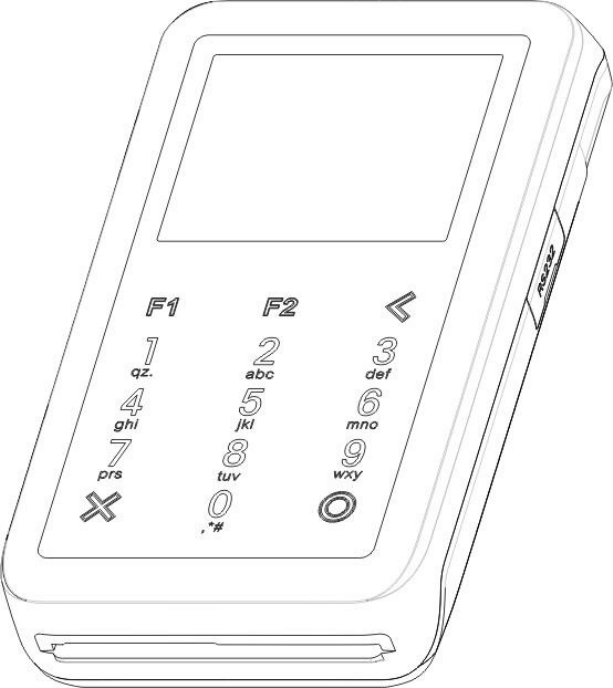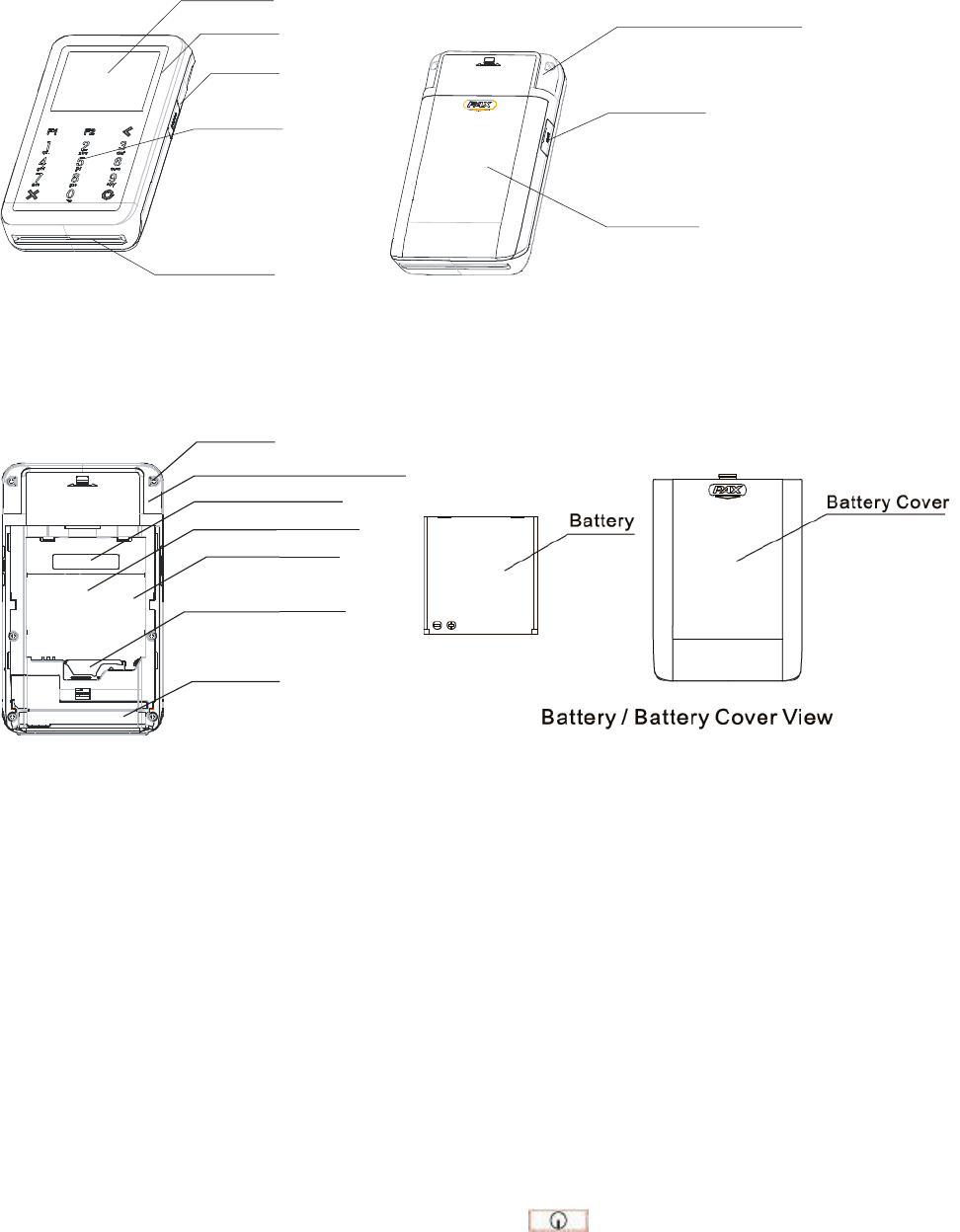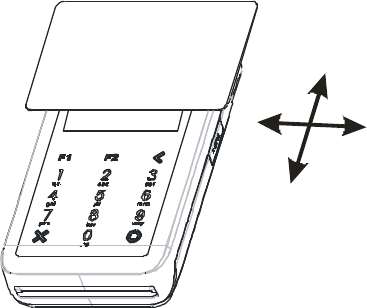PAX Technology D200WB Wireless POS Terminal User Manual
PAX Technology Limited Wireless POS Terminal
User manual

D200 Wireless POS Terminal
PAX TECHNOLOGY LIMITED

1. Production Description
LCD Dis p lay
RF An t e n n a Ar e a
Rs 2 3 2 Co n n ce t
Ca p a c it iv e Ke y Ar e a
Ic Ca r d Slo t
Ma g n e t ic St r ip Ca r d So lt
USB Co n n e ct
Ba t t e r y Co ve r
Front View Back View
Scre w
Ma gne tic St rip Car d Solt
Bar cod e La be l
Nam ep lat e Lab el
Bat t er y Ar ea
SAM/ SIM Ca r d Slot
Ant en n a
Back Layout Battery / Battery Cover View
2. Installation
1 SAM Card Installation
Open up battery cover, which is at the bottom of the terminal;
Take out battery;
Insert SAM card to corresponding SAM card slot.
2 Battery Installation
Hold the battery with its facing up;
Attach battery forelock to battery bayonet;
Press down the other side of the battery
3. Instruction
1 Power ON/OFF
Power on: Plug in power adapter or insert the battery, Press button for 3 seconds until

‘Di’ is heard, and then PAX LOGO will display on LCD.
Power off: Press button for 3 seconds until Shutting down... can be seen. POS terminal is
being turned off.
2 Magnetic Stripe Card
When user swipes magnetic stripe card along the slot, the backside of card, which contains
magnetic strip information, should be facing to the terminal. Bi-directional swiping is supported. It
is recommended to swipe starting from left to right (or from right to left) with a constant moving
speed.
3 IC card
When user insert IC card into the IC slot, the chip of IC card should be facing up; user is
recommended to gently insert the card, in order to avoid any physical damage to the card or the IC
slot of the terminal. If IC card is successfully read by the terminal, the IC card icon will be shown
on LCD display screen.
ICC Operation Process
Before inserting the IC card, please check inside and around the IC card slot. If there
is any suspicious object, please don‘t insert card and immediately report to the
relevant staff.
4) Contactless Card

Please refer to the picture below, the card read area is above the LCD.
4. Specifications
Default
CPU 32-bit,MIPS
Memory32MB SDRAM, 32MB NOR Flash
Display2.4 -inch 240x320 pixel color TFT LCDLED backlight
Keypad10 alphanumeric keys, 5 functional keys,touch key;
Magnetic Card Reader Track 1/2/3,bi-directional swipe
IC Card Reader1 user card EMV2000
SlotsSAM *1
SAM *1+ SIM *1 (only for GPRS Version)
Contactless Card ReaderISO/IEC 14443 Type A/B, Mifare/Felica/NFC
CommunicationBluetooth, WIFI, GPRS (Optional, depending on the version)
Peripheral Ports1 Micro USB(Device)
1 Mini USB(RS232)
Power SupplyInput100—240VAC ~0.2A 50/60HZ
Output5V DC 1A
BatteryLi-on battery,1300mAh, 3.7V
Working Environment Temperature0 ℃~50℃(32℉~122℉)
R.H.:10%~93%(non-condense)
Storage Environment Temperature:-20℃ ~ 70℃ (-4℉~158℉)
R.H.:5% ~95%(non-condense)
Dimensions120mm
72mm
22.1mmL
W
H
Weight165g(no battery)/200g(with battery)
5. Installation and Usage Tips
1)Do not damage electric wire and power adapter. If electric wire or power adapter is damaged ,
please do not use the terminal any more.
2)Before power adapter is plugged into power socket, please make sure that voltage which the
power socket supplies is appropriate working voltage for the terminal.
3)Do not expose the terminal in sunshine, or in humid, hot, or dusty environment
4)Keep the terminal away from liquid material
5)Do not plug any unknown material into any port of the terminal, since it may create serious
damage to the terminal.
6)If the terminal is defective, please contact professional POS repair technicians.
7)When D200 power supplied by the USB port of PC,we don’t recommend the use of CTLS
function.
8)When charged by the USB port of PC, charge time will be longer, we recommend charging
using the adapter.
9)When D200 is in charging, if you can't turn on the device, and you just hear "Di Di", please
charge it for longer, and try again later.
6.Battery Usage Tips
1) Charge indoor by PAX charger, where is cool and well ventilated;
2) Do not apart the battery;
3) Do not short circuit the battery;
4) Keep the battery away from sunshine, smog and dust;
5) Do not squeeze, punch the battery, put it into liquid or near fire;
6) Keep way from environment which is too hot , too cold, damp and highly explosive;
7) Once a failure happens such as heating or distortion, or it was broken down. Please change new
battery;
8) Change new battery if it cannot satisfy your requirement;
9) Change new battery if using more than two years.
P/N200312000000171
FCC Regulations:
This device complies with part 15 of the FCC Rules. Operation is subject to the following two
conditions: (1) This device may not cause harmful interference, and (2) this device must accept
any interference received, including interference that may cause undesired operation.
This device has been tested and found to comply with the limits for a Class B digital device,
pursuant to Part 15 of the FCC Rules. These limits are designed to provide reasonable protection
against harmful interference in a residential installation. This equipment generates, uses and can
radiated radio frequency energy and, if not installed and used in accordance with the instructions,
may cause harmful interference to radio communications. However, there is no guarantee that
interference will not occur in a particular installation If this equipment does cause harmful
interference to radio or television reception, which can be determined by turning the equipment off
and on, the user is encouraged to try to correct the interference by one or more of the following
measures:
-Reorient or relocate the receiving antenna.
-Increase the separation between the equipment and receiver.
-Connect the equipment into an outlet on a circuit different from that to which the receiver is
connected.
-Consult the dealer or an experienced radio/TV technician for help.
Changes or modifications not expressly approved by the party responsible for compliance could
void the user‘s authority to operate the equipment.
Cet appareil est conforme aux dispositions de la partie 15 des règles de la FCC et
des normes CNR d'Industrie Canada sur les appareils radio exempts de licence. Son
utilisation est assujettie aux deux conditions suivantes : (1) Cet appareil ne doit pas
causer d'interférence nuisible; et (2) cet appareil doit accepter toute interférence
reçue, y compris l'interférence qui pourrait causer un fonctionnement non désiré.
Cet équipement a été testé et jugé conforme aux limites d'un appareil numérique
de la Classe B, en vertu de la partie 15 des règles de la FCC et de la NMB-003
canadienne. Ces limites sont conçues pour fournir une protection raisonnable
contre l'interférence nuisible dans une installation résidentielle. Cet équipement
génère, utilise et peut émettre de l'énergie radiofréquence et, s'il n'est pas installé
et utilisé conformément aux instructions, peut causer une interférence nuisible
aux communications radio. Toutefois, il n'est pas garanti que l'interférence ne
se produira pas dans une installation particulière. Si cet équipement cause une
interférence nuisible à la réception radio ou de programmes de télévision, laquelle
peut être déterminée en éteignant et en allumant l'équipement, l'usager est
encouragé à essayer de corriger l'interférence par l'une ou plusieurs des mesures
suivantes :
• Réorientez ou relocalisez l'antenne de réception.
• Augmentez la séparation entre l'équipement et le receveur.
• Connectez l'équipement à une prise sur un circuit différent de celui auquel
de le receveur est connecté.
• Consultez le vendeur ou un technicien radio/de télévision pour obtenir de l'aide.
La FCC ou Industrie Canada peut vous obliger à arrêter d'utiliser votre appareil si
une telle interférence ne peut pas être éliminée.
D200 n'a pas approuvé les changements ou modifications apportés à cet appareil
par l'usager. Tous les changements ou modifications apportés peuvent entraîner la
révocation de l'autorisation d'utilisation de l'appareil.
FCC RF Exposure Information (SAR)
This device is designed and manufactured not to exceed the emission limits for exposure to
radio frequency (RF) energy set by the Federal Communications Commission of the United
States.
During SAR testing, this device is set to transmit at its highest certified power level in all
tested frequency bands, and placed in positions that simulate RF exposure in usage near the
body with the separation of 0 mm. Although the SAR is determined at the highest certified
power level, the actual SAR level of the while operating can be well below the maximum
value. This is because the device is designed to operate at multiple power levels so as to use
only the power required to reach the network. In general, the closer you are to a wireless
base station antenna, the lower the power output.
The exposure standard for wireless employs a unit of measurement known as the Specific
Absorption Rate, or SAR. The SAR limit set by the FCC is 1.6W/kg.
The FCC has granted an Equipment Authorization for this model device with all reported
SAR levels evaluated as in compliance with the FCC RF exposure guidelines. SAR
information on this model device is on file with the FCC and can be found under the Display
Grant section of www.fcc.gov/oet/ea/fccid after searching on FCC ID: V5PD200WB.
For this device, the highest reported SAR value for near the body is 0.99 W/kg.
While there may be differences between the SAR levels of various devices and at various
positions, they all meet the government requirement.
SAR compliance for body operation is based on a separation distance of 0 mm between the
unit and the human body.
IC Notice
This device complies with Industry Canada license-exempt RSS standard(s). Operation is subject
to the following two conditions:
(1) this device may not cause interference, and
(2) this device must accept any interference, including interference that may cause undesired
operation of the device.
Le présent appareil est conforme aux CNR d'Industrie Canada applicables aux appareils radio
exempts de licence. L'exploitation est autorisée aux deux conditions suivantes:
(1) l'appareil ne doit pas produire de brouillage, et
(2) l'utilisateur de l'appareil doit accepter tout brouillage radioélectrique subi, même si le
brouillage est susceptible d'en
This Class B digital apparatus complies with Canadian ICES-003.
Cet appareil numérique de la classe B est conforme à la norme NMB-003 du Canada.
IC: 11689A-D200WB
IC Radiation Exposure Statement
This EUT is compliance with SAR for general population/uncontrolled exposure
limits in IC RSS-102 and had been tested in accordance with the measurement
methods and procedures specified in IEEE 1528 and IEC 62209. This equipment
should be installed and operated with minimum distance 0 cm between the
radiator and your body. This device and its antenna(s) must not be co-located or
operating in conjunction with any other antenna or transmitter.
Cet appareil est conforme aux limites d'exposition DAS incontrôlée pour la population
générale de la norme CNR-102 d'Industrie Canada et a été testé en conformité avec
les méthodes de mesure et procédures spécifiées dans IEEE 1528 et IEC 62209.
Cet appareil doit être installé et utilisé avec une distance minimale de 0 cm entre
l’émetteur et votre corps. Cet appareil et sa ou ses antennes ne doivent pas être
co-localisés ou fonctionner en conjonction avec tout autre antenne ou transmetteur.